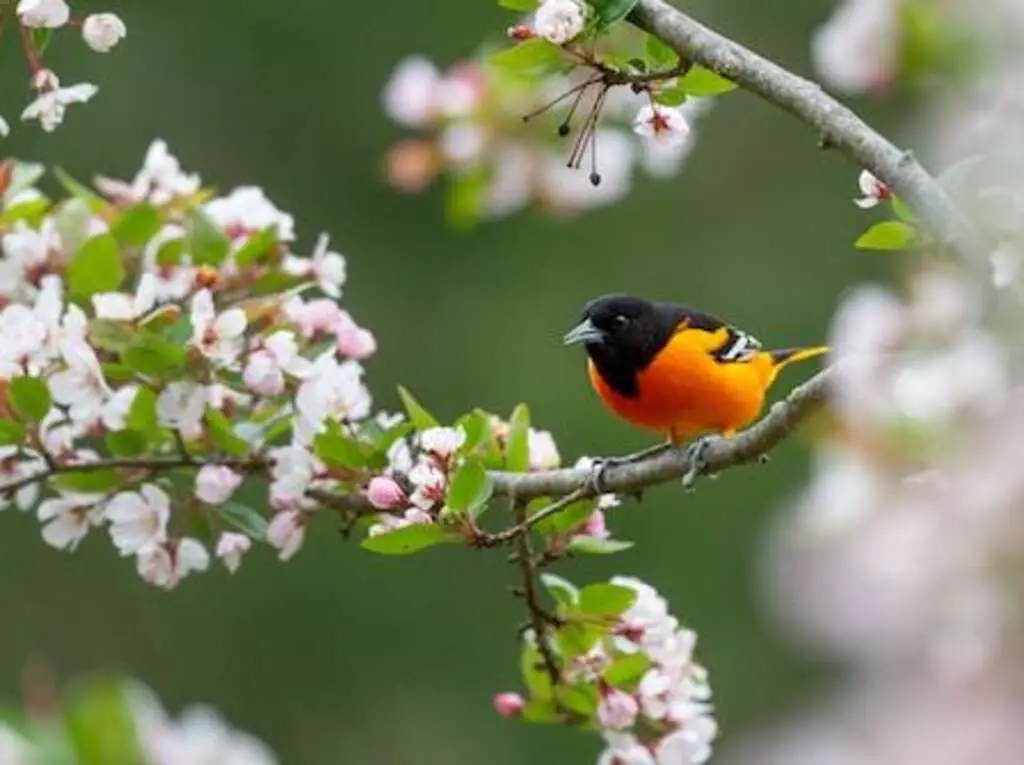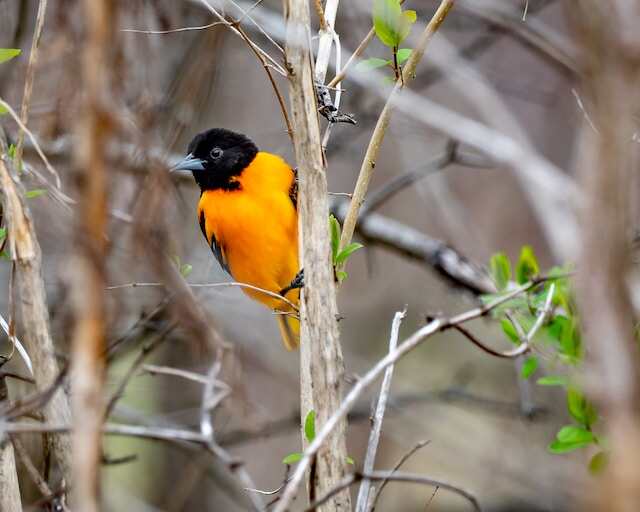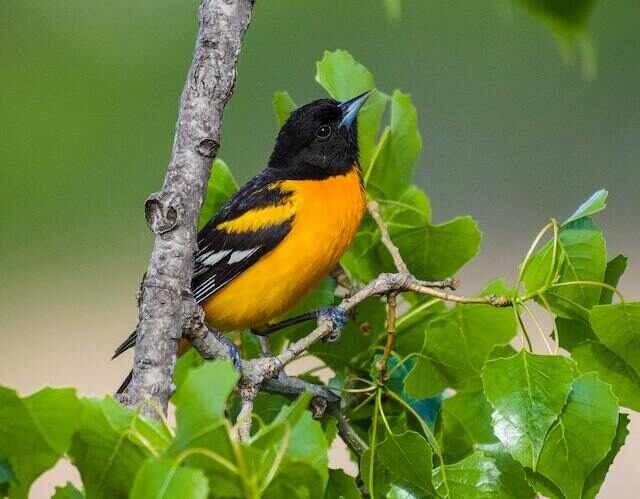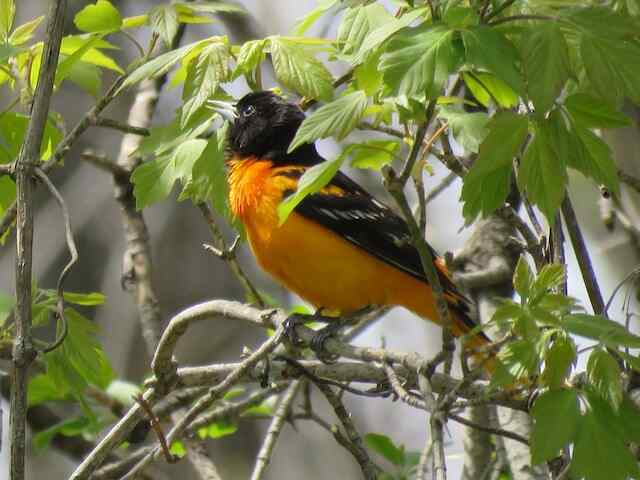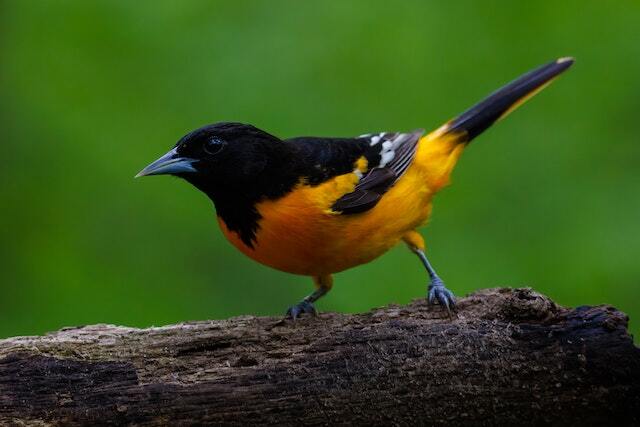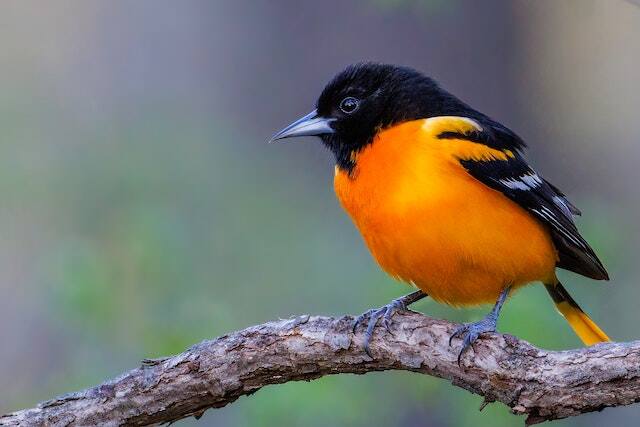Have you ever wondered, what does a Baltimore Oriole nest look like? These striking songbirds, known for their orange and black plumage, create intricate nests using grasses, milkweed fibers, and spider silk.
Hang on for a captivating journey as we delve into the world of these stunning nests, revealing their location, weaving techniques, size, and design.
Table of Contents
- 1 Introduction to Baltimore Orioles and their Nests
- 2 What Does A Baltimore Oriole Nest Look Like?
- 3 Nest Location and Habitat
- 4 Nest Materials
- 5 Nest Weaving Techniques
- 6 Nest Size and Design
- 7 Nest Lining
- 8 Oriole Chicks and Nesting Period
- 9 Conclusion and Conservation Efforts
- 10 Frequently Asked Questions
- 10.1 How long does it take for a Baltimore Oriole to construct its nest?
- 10.2 How many eggs does a Baltimore Oriole typically lay in a nest?
- 10.3 What is the average lifespan of a Baltimore Oriole?
- 10.4 Do Baltimore Orioles reuse their nests from previous years?
- 10.5 How do Baltimore Orioles defend their nests from predators?
- 11 Overall Conclusion
- 12 Author
Introduction to Baltimore Orioles and their Nests
The construction of Baltimore Oriole nests is a marvel of avian engineering, showcasing intricate weaving of plant fibers and grasses to create a sturdy and functional structure.
These birds are known for their bright orange plumage and melodious songs, and they are found across North America during the breeding season.
Baltimore Orioles are known to be migratory birds, traveling to Central and South America during the winter months.
However, despite their impressive nest building skills, these birds face many challenges in their habitat. Predators, such as snakes, squirrels, and even other birds, can pose a threat to Baltimore oriole nests.
These birds typically build their nests in trees, often near the end of branches for added protection.
As we explore the nest location and habitat of these birds, we will gain a greater understanding of their unique behaviors and adaptations.
What Does A Baltimore Oriole Nest Look Like?
A Baltimore Oriole nest is a marvel of avian architecture. Woven from grasses, milkweed fibers, and spider silk, these nests are often large and elaborate, hanging from tree branches.
Their intricate design showcases the bird’s craftsmanship. Explore the beauty and intricacy of Baltimore Oriole nests.
Nest Location and Habitat
Baltimore Orioles typically build their nests in tall deciduous trees, with a preference for those that are located near sources of water.
The nests are often suspended from the outer branches of these trees, typically at a height of 20 to 30 feet above the ground.
This location provides the nest with protection from predators and allows the Orioles to easily access food and water sources.
Tall Deciduous Trees
Towering deciduous flora provide a prime location for the avian domicile of the state bird of Maryland, the Baltimore Oriole.
The deciduous tree species, with their sturdy branches and ample foliage, are the perfect location for the oriole’s hanging nests.
The importance of tree height in nest placement cannot be overstated, as the orioles prefer to build their nests high above the ground, away from predators and other potential threats.
The sight of an oriole’s nest swaying gently in the breeze, surrounded by lush greenery and bathed in sunlight, evokes a sense of peace and tranquility.
It is no wonder that birdwatchers and nature enthusiasts alike are drawn to witness this marvel of avian architecture.
As we move on to the next section about the suspension of the nest, it is clear that the oriole’s nest is not just a simple structure but a marvel of engineering and innovation.
Suspension of the Nest
The hanging structure of the avian abode is a testament to the oriole’s ingenuity in creating a stable and secure environment, despite being suspended high above the ground.
The nest suspension technique provides several benefits for the Baltimore Oriole, such as avoiding ground-based predators and reducing the risk of flooding during heavy rain.
By suspending their nests from a branch, the orioles also protect their offspring from other natural predators, including snakes and raccoons, that may climb up trees.
The suspension of the nest also helps to maintain a stable temperature for the young birds, as it is less exposed to the elements.
The Baltimore Oriole’s ability to suspend their nests in such a way showcases their remarkable adaptability and resourcefulness.
However, despite their efforts, their nests are still vulnerable to destruction by strong winds, storms, and other environmental factors.
This highlights the importance of the materials used for nest building, which will be discussed in the subsequent section.
Nest Materials
The assortment of items used in the construction of the Baltimore Oriole’s abode is as eclectic as it is effective. The nest materials are meticulously chosen and arranged to create a sturdy and comfortable structure.
The Baltimore Oriole uses a variety of fibers such as grasses, plant fibers, and even human-made materials like string and yarn.
This diversity in materials is a testament to the bird’s ingenuity and resourcefulness. When compared to other bird species, the Baltimore Oriole’s nest stands out due to its unique blend of materials.
It’s fascinating to note how these small creatures can create something so complex and functional using only their beaks and feet.
As you observe the intricacies of the Baltimore Oriole’s nest, you can’t help but feel a sense of awe and wonder at the incredible feats of nature.
The use of human-made materials in the nest evokes a sense of connection between humans and nature, reminding us of our shared responsibility to protect the environment.
In the subsequent section about nest weaving techniques, we will delve deeper into the process of nest construction and the skills required to create such a masterpiece.
Nest Weaving Techniques
This section explores the intricate techniques utilized by the Baltimore Oriole in the weaving of its nest, revealing the remarkable skills and abilities of this species in creating a sturdy and comfortable home.
The Baltimore Oriole is known for its remarkable weaving skills, which are used to create a nest that can withstand the harsh elements of nature.
The birds use a variety of materials to construct their nests, including grass, twigs, and other natural materials.
The weaving patterns of the Baltimore Oriole are also quite impressive, with the birds weaving together strands of grass and other materials in a way that creates a sturdy and durable structure.
The color choices of the birds when constructing their nests are also notable, with the birds often using bright and vibrant colors to attract mates and deter predators.
All of these techniques and skills combine to create a nest that is both functional and aesthetically pleasing.
In the next section, we will explore the size and design of the Baltimore Oriole nest in more detail.
Nest Size and Design
The size and design of the nest of the Baltimore Oriole species are remarkable, showcasing the bird’s ability to create a functional and comfortable home through the intricate weaving of natural materials, akin to a master craftsman creating a masterpiece out of raw materials.
Baltimore Oriole nests are unique, as they are woven in the shape of a pendant that hangs from a tree branch, with a small entrance hole on the top.
The nests are made up of a complex weave of plant fibers, such as grasses, vines, and bark strips, which are held together by spider silk.
The silk not only provides structural support but also adds durability to the nest, making it strong enough to withstand the weather and protect the eggs and chicks from predators.
The nests can be up to six inches in diameter and can take up to two weeks to build. The intricate weaving of the nest provides a natural camouflage, making it difficult for predators to spot.
The birds also use plant fibers with thorns to add an extra layer of protection against predators.
The design and size of the nest also play an important role in temperature regulation, as the pendant shape allows for good ventilation and prevents the accumulation of heat in the nest.
The nest lining is another important aspect of the Baltimore Oriole’s nest, providing a soft and comfortable bed for the chicks.
Nest Lining
The construction of a comfortable and safe nest for the Baltimore Oriole chicks requires not only intricate weaving of plant fibers and spider silk but also a carefully chosen and arranged nest lining.
This lining serves as insulation and helps maintain a consistent temperature inside the nest.
Here are four things to know about nest lining for the Baltimore Oriole:
(1) The lining is made up of soft materials such as animal hair, feathers, and fine plant fibers.
(2) The material is carefully arranged in a bowl shape to create a soft and cozy bed for the chicks.
(3) The lining is periodically replaced to keep the nest clean and free of parasites.
(4) The Baltimore Oriole parents use their beaks to adjust the lining and maintain the nest’s shape.
Understanding the importance of nest insulation and maintenance highlights the importance of the nesting period for the Baltimore Oriole chicks and their development.
Oriole Chicks and Nesting Period
As mentioned in the previous subtopic, orioles are meticulous nest builders. But what happens after the nest is built? Once the female lays her eggs, she spends much of her time incubating them.
After about two weeks, the eggs hatch into naked, helpless chicks. It is during this time that the oriole parents work tirelessly to feed their young.
Oriole chicks have voracious appetites and require a steady supply of insects to grow and develop.
The parents will make numerous trips back and forth to the nest, bringing back spiders, caterpillars, and other insects to feed their young.
However, this feeding frenzy also attracts predators like snakes, squirrels, and birds of prey. This means that the oriole parents must remain vigilant and protect their young from potential threats.
Understanding oriole feeding habits and the dangers they face from predators is crucial in protecting these beautiful birds.
| Positive Emotions | Negative Emotions |
|---|---|
| Appreciation | Concern |
| Wonder | Fear |
| Fascination | Anxiety |
| Awe | Worry |
| Admiration | Apprehension |
In conclusion, orioles are fascinating creatures that exhibit incredible nesting behaviors. However, their survival is threatened by habitat loss and predation.
As such, conservation efforts must be made to protect these birds and their habitat, not just for their sake but also for the sake of other wildlife that relies on similar habitats.
Conclusion and Conservation Efforts
Efforts to conserve and protect the habitat of orioles are crucial for the preservation of these fascinating birds and the diverse wildlife that depends on their habitat.
The Baltimore Oriole, with its intricate and unique nest, is a prime example of the importance of bird nests.
These nests are woven together with plant fibers and hair, and are suspended from a branch by a sturdy rim, providing a safe haven for the oriole chicks.
Unfortunately, habitat loss and fragmentation have led to a decline in the number of orioles, highlighting the urgent need for conservation efforts.
By preserving their natural habitat and protecting the trees that they nest in, we can ensure the survival of these beautiful birds and the wildlife that depends on them for food and shelter.
It is imperative that we continue to research and implement strategies to protect and conserve the habitats of these birds, so that they can continue to thrive and contribute to the biodiversity of our planet.
Frequently Asked Questions
How long does it take for a Baltimore Oriole to construct its nest?
Baltimore orioles are known for their intricate and well-crafted nests, which are constructed using a variety of materials and techniques.
Research has shown that the efficiency of nest building is impacted by the habitat in which the orioles live.
For example, orioles living in areas with abundant resources, such as trees and shrubs, tend to build nests more quickly and with greater precision than those living in areas with fewer resources.
Additionally, the materials used in nest construction can vary depending on the availability of resources.
For instance, orioles may use a combination of grasses, plant fibers, and even human-made materials like string or yarn.
Overall, the construction of a Baltimore oriole nest is a complex and fascinating process that highlights the ingenuity and adaptability of these remarkable birds.
How many eggs does a Baltimore Oriole typically lay in a nest?
Baltimore orioles generally lay 3-7 eggs per clutch, with an average of 4-5 eggs.
The breeding season for Baltimore orioles usually begins in May and lasts until early July.
Incubation period for the eggs is approximately 12-14 days, and both male and female take turns incubating the eggs.
The female oriole is responsible for building the nest, which typically takes 8-12 days to construct.
The nest is a unique, hanging pouch-like structure that is woven together using plant fibers, grasses, and string.
While Baltimore orioles are known for their beautiful and intricate nests, the focus of this discussion is on their breeding habits and incubation period, rather than on the physical appearance of their nests.
What is the average lifespan of a Baltimore Oriole?
The average lifespan of a Baltimore Oriole is approximately 7 years.
These birds have a diverse diet consisting of insects, fruit, and nectar. During migration, they rely on nectar as their primary food source.
Baltimore Orioles are monogamous and exhibit elaborate courtship displays. They build hanging nests that are woven from plant fibers and animal hair. The nests are typically located in the branches of tall trees or shrubs.
Breeding habits of Baltimore Orioles are influenced by factors such as climate and food availability. During breeding season, males defend their territory and court females through song and display.
Overall, Baltimore Orioles are fascinating birds that exhibit unique behaviors and adaptations to their environment.
Do Baltimore Orioles reuse their nests from previous years?
Like a phoenix rising from the ashes, the Baltimore Oriole’s nest is a symbol of rebirth and renewal. Nest Reuse, however, is not a common practice among these migratory birds.
Research suggests that the Baltimore Oriole prefers to build a new nest each breeding season, which coincides with their migration patterns.
These nests, intricately woven from plant fibers and animal hair, are a marvel of engineering. The hanging nests are suspended from the tips of branches, providing a safe haven for their young.
While the Baltimore Oriole’s nest may not be reused, their annual migration patterns continue to fascinate scientists and bird enthusiasts alike.
With each passing year, we uncover more about these magnificent creatures and their instinctual drive to innovate and adapt to their ever-changing environment.
How do Baltimore Orioles defend their nests from predators?
Baltimore orioles use several strategies to defend their nests from predators and ensure the survival of their offspring.
One of these strategies is predator avoidance, which involves detecting and avoiding potential threats in the surrounding environment.
Orioles also use nest camouflage to blend in with their surroundings and make it more difficult for predators to locate their nest.
This involves selecting materials for the nest that match the colors and textures of nearby foliage, such as grass, twigs, and leaves.
By combining these strategies, Baltimore orioles are able to protect their nests and ensure the survival of their young.
Overall Conclusion
In conclusion, Baltimore Orioles are known for their intricate and skillfully woven nests. These nests are made up of a variety of materials, including grasses, plant fibers, and even animal hair.
The weaving technique used by these birds is impressive and unique, as they create hanging nests that sway gracefully in the wind.
During the nesting period, Baltimore Oriole chicks are taken care of by their parents, who diligently provide them with food and protection.
These birds prefer to nest in deciduous trees, and their nests are often found in the upper branches.
It is important to note that conservation efforts are necessary to maintain the population of these beautiful birds, as they are susceptible to habitat loss and other threats.
Overall, the Baltimore Oriole’s nest is a marvel of nature, showcasing the ingenuity and adaptability of these birds.
By understanding the intricacies of their nests and nesting habits, we can better appreciate the importance of preserving their habitat and ensuring their survival for future generations.

